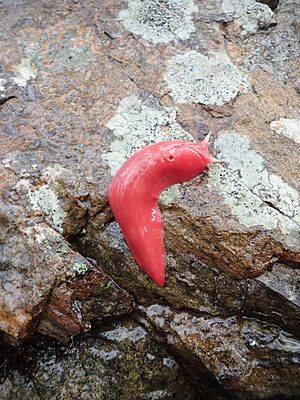Triboniophorus sp. nov. 'Kaputar' facts for kids
Quick facts for kids Triboniophorus sp. nov. 'Kaputar' |
|
|---|---|
 |
|
| Conservation status | |
| Scientific classification |
|
| Kingdom: | Animalia |
| Phylum: | Mollusca |
| Class: | Gastropoda |
| Subclass: | Heterobranchia |
| Clade: | Euthyneura |
| Order: | Panpulmonata |
| Clade: | Eupulmonata |
| Clade: | Stylommatophora |
| Infraorder: | Succineoidei |
| Superfamily: | Athoracophoroidea |
| Family: | Athoracophoridae |
| Subfamily: | Aneitinae |
| Genus: | Triboniophorus |
| Synonyms | |
|
|
Meet the Mount Kaputar pink slug'! This amazing creature is a giant slug known for its bright, hot pink color. You can only find these special slugs on Mount Kaputar in Australia. Scientists have confirmed it's a unique species, different from the more common "red triangle slug."
Contents
Where Do Pink Slugs Live?
The Mount Kaputar pink slug lives only at the very top of Mount Kaputar. This mountain is in New South Wales, Australia, inside the Mount Kaputar National Park. These slugs live at a high altitude, about 1,500 meters (almost 5,000 feet) up. They are surrounded by snow gum trees.
This area is like a special "sky island" because it's much cooler and wetter than the dry plains around it. It gets rain and even snow! This unique environment helps the pink slugs and other special plants and animals live there, even though they are isolated from other places. Scientists believe they stay within an area of about 100 square kilometers (about 38 square miles).
Sadly, about 90% of these slugs were lost in the big Australian bushfires of 2019.
Life of a Pink Slug
You can often see hundreds of these slugs on cool, wet, and misty mornings. During the day, they hide in the plant litter (like fallen leaves and twigs) at the bottom of trees. When night comes, they crawl up the tree trunks. They eat algae and mosses that grow on the trees. In the early morning, they climb back down to hide, repeating their daily cycle.
Pink slugs are important for their ecosystem. They help break down plant litter, turning it into rich soil that helps new plants grow. They also become food for birds and other animals.
What Do Pink Slugs Look Like?
These slugs are a very bright, fluorescent pink color. They can grow quite large, up to about 20 centimeters (almost 8 inches) long! A park ranger once said they are "as bright pink as you can imagine."
How Did They Get Here?
The Mount Kaputar pink slug is related to, but not the same as, the red triangle slug. Scientists have confirmed that the fluorescent pink species is truly unique.
These slugs have relatives in places like New Guinea, New Caledonia, New Zealand, and eastern Africa. This might seem strange, but it's because these land masses were once connected long ago as a huge supercontinent called Gondwana.
About 17 million years ago, a volcano erupted at Mount Kaputar. This created the high-altitude area where these slugs live today. They, along with other creatures and plants, have lived isolated there for millions of years. This happened after the rainforests that used to cover eastern Australia disappeared due to changes in the climate.


